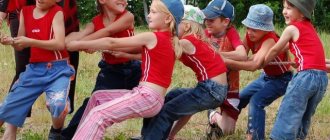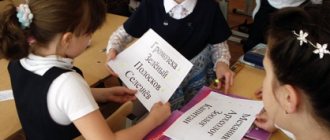Creation of a quest game (fairy tale quest for students) methodological development on the topic
Creation of quest games, quest events
INTRODUCTION:
In connection with new educational standards and the introduction of the Federal State Educational Standard into the educational sphere of modern society, the attitude of children towards holidays is also changing. Currently, the use of ICT technologies is of great importance for both children and teachers. A modern child is a person who understands most of the latest “gadgets,” but at the same time, they are often used for other purposes. The teacher’s task is to engage. Involve everywhere and everywhere in educational and creative activities.
Modern kids don’t have enough games based on stations; they are more interested in whole game scenarios to achieve various goals. Recently, the children's movement of our school has been holding regular quests - games, quests - holidays. Over the course of several years, this type of work has acquired special significance for both educational and creative activities. Let's look at the definition: quest [1] (borrowing from the English Quest - “search, subject of search, search for adventure, fulfillment of a knightly vow”). In mythology and literature in English, the concept of “quest” originally denoted one of the ways of constructing a plot - the journey of characters to a specific goal through overcoming difficulties (for example, the myth of Perseus or even the 12 labors of Hercules). Typically, during this journey, the heroes have to overcome numerous difficulties and meet many characters who help or hinder them. Heroes may undertake a quest for personal gain or other reasons. Completing some quests is associated with solving moral and ethical problems. Similar plots gained great popularity in knightly novels, in particular, one of the most famous quests of the Knights of the Round Table - the search for the Holy Grail. The frame type of quest in the novel seems to coincide with some kind of deep narrative structure. This technique is used especially actively in the fantasy genre. Since this genre is closely related to role-playing games, the term migrated to games, slightly changing its meaning.
So, a quest is an adventure game that takes you from point A to point B by solving assigned tasks.
The design of a real quest can be large and massive, it all depends on the number of participating teams and stages. The quest is really similar to the station game, but has a significant difference: in the first case, the guys are openly told where to go (or given a map), in the second, the guys are given a task, after completing which they must understand where to go.
Quest games have a classification that I found on the forum[2]:
Story - quests aimed at the sequential development of game events;
Non-story quests - quests aimed at legalizing the development of game events.
Kinds:
- One-time - quests completed once per game. - Reusable - quests, regularly completed (daily, weekly, periodically - once every few days). Type of quests: - Single - completed individually. - Group - completed with 2 or 3 - x, 4 players, as part of a clan, for example, at least 10 players, alliance, for example, at least 15 players. Type of quests - Survival (defense) - the player’s actions alone or (as well as) as part of a group , aimed at holding territory on various terrains (optionally, for a certain time, until the main forces arrive). — Elimination (attack) - actions of the player alone or (as well as) as part of a group, aimed at destroying/suppressing enemy forces (of varying numbers) in different areas. (possibly for a while) - Espionage/sabotage - actions of the player alone or (as well as) as part of a group, aimed at capturing important documentation, taking the “language” and other people, with their subsequent delivery accordingly. organs. Destruction of buildings, structures, structures, as well as vehicles by mining. (possibly for a while) - Search / trading operations - actions of the player alone or (as well as) as part of a group, aimed at detecting, delivering and, possibly, in the process of combat clashes with the enemy, various cargoes and objects. (possibly for a while) - Peaceful - actions of the player alone or (as well as) as part of a group, aimed at delivering various items to the NPC (possibly for a while). The principle of peaceful quests is - find -> receive a reward, - find -> bring - > get a reward, - find -> report -> get a reward, - bring/take -> get a reward,
Of course, not all types of quests are suitable for the modern education system, but only peaceful and search ones.
There is a certain structure of game quests:
- The presence of interesting characters (human actors, with the attributes of the heroes they portray)
- Availability of rewards for completed tasks (for example, tokens, or receiving part of the answer to the main question of the game, at the end of the game, certificates for places, cups, etc.)
- The presence of a team leader (not a prompter, but an assistant)
How to create a quest game with students? You can use the spinner technology
Stages of creating a quest game with students:
- Topic selection:
Every teacher should realize that it is necessary not only to tell the children what they should do, but to try to create an atmosphere of desire. You can tell the kids about what a quest is, and whether they think that they themselves can become the creators of the game here and now. Offer them topics (several options), and choose one of them by voting. Or offer to create a game for some school event or upcoming holiday.
- Determining the target category (number of teams, their age) and determining the scale of the quest (office, school, district, city...):
Determine who the game will be aimed at, for whom the initiative group could hold such an event, with whom the group would be comfortable working (the complexity of the tasks and the heroes that the teams will meet depend on the age of the participants)
- Determining the number of stages:
Divide the guys into several groups (this can be done after determining the stages of the game), for example, 5 groups of 4 people.
- Guys work in teams
The work of children in teams can be carried out in several ways:
- using a sheet of Whatman paper in each group
- using a pre-prepared questionnaire
- using a computer class (using ICT)
Need answers to questions:
- Come up with a hero's name
- Name 3 character traits of the hero
- What does the hero look like?
- How does the hero talk (slow, fast...)
- Where the hero is located (depending on the choice of location for the quest)
- Riddle about the hero
- Hero's task (team action on the spot)
Each team must either answer all questions in full, or answer them using the “spinner” method (1, 2,3,4,.... For a certain amount of time)
- Introducing fictional characters
Oral defense of invented characters (with possible reincarnation)
- Determining the order of presentation and search for heroes (when there is one team, this is easy, when there are several of them, you should follow the rule: number of teams = number of heroes)
- Determination of the results of the game, possible determination of nominations and awards.
It should be recalled that at each stage there must be encouragement (tokens, part of the final task, etc.)
- Distribution of quest game roles between participants, creation of a schedule of individual rehearsals, selection of costumes (determination of the roles of presenters and persons accompanying the teams).
- Conducting a survey on whether the children liked taking part in the creation of the game.
What difficulties did they encounter?
This is how our team creates scenarios for quest games and quest fairy tales dedicated to various festive events; it’s especially nice when the elders create wonderful holidays for the younger ones. The quest can last 1-3 hours. Most often, it is not only entertaining, but also educational and educational in nature, so you should not think that the lessons can be wasted, especially if the tasks are selected to motivate the desire to study the subjects. And now I would like to introduce you to two scenarios of the quests. The first is dedicated to the wonderful holiday - “New Year”, where DiMOO "ONYX" held a New Year's fairy tale with obstacles for the pupils of the beadwork circle, the second is an instructive game - a story about the life and work of the great scientist Lomonosov, which was held by DiMOO for several parallel classes.
[1] Material from Vekipedia (electronic encyclopedia)
[2] https://forum.lsonline.ru/index.php?/topic/659-%D0%BE%D0%BF%D0%B8%D1%81%D0%B0%D0%BD%D0%B8 %D0%B5-%D1%80%D0%B0%D0%B7%D0%BB%D0%B8%D1%87%D0%BD%D1%8B%D1%85-%D0%BA%D0%B2 %D0%B5%D1%81%D1%82%D0%BE%D0%B2/
Article “School quest. From idea to practical implementation"
Syrnikova S.A., Sheptura A.A.
"School quest. From idea to practical implementation
»
Currently, the development of a positive motivational school environment can be considered a necessary condition for improving the quality of education. Motivation is responsible for the child’s active position in learning and personal development.
To help increase students’ interest in the subjects they are studying, to try out a new form of organizing extracurricular activities and intellectual leisure, to create conditions for the development of children’s creative abilities and their self-affirmation - the authors chose the implementation of the “School Quest” project as one of the ways to solve these issues. This is a modern type of intellectual team games that requires productive generation of ideas and non-standard solutions. Psychologists say that quest technology improves the perception of educational material, contributes to the moral development of the child as an individual, and can stimulate the mental and moral development of children. Quests are a great way of group interaction. Participants in the game have to interact with each other, analyze available information, use dexterity, erudition and all their skills. The child discovers new abilities and character traits, while receiving vivid emotions and unforgettable impressions. And, what is especially important, quests take children out of virtual communication into real ones. But the process of creating a quest is even more exciting. When developing a quest, everyone is given the opportunity to gain experience in project activities by involving them on a voluntary basis in the development of an interdisciplinary gaming space at all stages: from idea to practical implementation.
About the project. The goal of the project: to meet the needs of children in engaging in socially significant activities, creative development, improving educational and cultural levels, self-realization, as well as the formation of moral qualities, developing children’s self-government, increasing the motivational environment of the school by creating a play space and its further operation.
The goal is achieved by solving the following tasks:
- identifying and uniting creative youth;
- organizing practice-oriented activities for students by involving them on a voluntary basis in the development and creation of an interdisciplinary gaming space;
- the use of gaming space to organize intellectual leisure for students who are not involved in its development and creation.
The solution to the first task includes holding information meetings with schoolchildren, working with promotional materials (advertising stand, announcements, etc.), uniting interested youth within the framework of a school club, which opens up opportunities for the development of children’s self-government, communication with peers, and the formation of moral qualities, informal communication between teachers and students.
Solving the second problem implies:
- choosing a quest topic,
- development of projects for intellectual tasks of interdisciplinary gaming space and their implementation,
- design of the playing space.
The correct choice of quest topics allows you to increase interest and motivate children to study a particular block of disciplines.
Developing projects for intellectual tasks allows you to reveal the creative abilities and interests of children. When implementing project assignments, a more in-depth study of certain issues is required, which undoubtedly leads to the study of additional literature, cooperation with specialist teachers and parents. Practice-oriented activities of students allow them to realize their own importance, raise self-esteem, and self-realization.
Work on the design of the play space contributes to the formation of a positive attitude towards work and the development of aesthetic qualities.
The implementation of the third task, related to the operation of the created gaming space, involves completing intellectual tasks as a team in a limited time. This makes it possible to organize intellectual leisure for children who are not involved in the development of the quest. Difficulties that arise when passing through the play space also contribute to children’s interest in the disciplines they study.
Contents of the project implementation stages:
- Identifying and uniting creative youth
- holding information meetings with schoolchildren
- working with promotional materials (advertising stand, announcements, etc.)
- bringing together interested youth within a school club
- Choosing a quest theme
- The theme of the quest is determined based on the interests of schoolchildren, their capabilities, educational goals, and the need for motivation to study a particular block of disciplines.
- drawing up the initial version of the game script.
- Development of projects for intellectual tasks of the gaming space
- putting forward task ideas;
- their discussion;
- uniting participants into creative groups and assigning tasks to them;
- detailed study of each task with the preparation of a technological map for its production and a list of necessary materials, tools, equipment;
- if necessary, study additional literature, consultation and cooperation with specialist teachers and parents;
- making changes and adjustments to the game script.
- Implementation of assignment projects
- acquisition of necessary materials;
- performing technological operations to implement project assignments;
- testing of tasks, with their further refinement if necessary.
- Design of the playing space
- design of the premises;
- placement, fastening, installation of tasks;
- design of the final game script.
- Play space testing
- completing the quest with trial teams;
- identifying shortcomings in the work of the quest and eliminating them;
- Preparation of documentation for a school quest
- development of a project passport;
- development of business cards, memorable badges for winners.
- Operation of the playing space
- team completion of intellectual tasks in a limited time;
- game support;
- maintaining the play area in working order.
Results of practical activities:
When implementing the project
- an interdisciplinary gaming space “School quest “The Secret of the Third Planet” was created, consisting of 2 locations and containing 14 tasks. Brief scenario of the quest: “Alice, the main character of the famous remake story by Kir Bulychev, again goes on a space expedition, where she encounters a problem that only the quest participants can solve within one hour. They will have to penetrate a secret laboratory located on Earth, collect fragments of the encrypted code, decipher it and send the password to start the engines to the spaceship.”
- The play space is operated regularly. Teams are formed from students in grades 8-11, teachers, and school guests. Only positive feedback was received from players who completed the quest. Players note the variety and excitement of the tasks, the interesting scenario, the atmosphere of the quest and the high level of design work. And it is extremely important that these works were carried out by their comrades and teachers. Some guys have already expressed a desire to participate in the creation of a new play space.
The results allow us to consider the experience gained positive. Prospects for further work in this direction include modernization and modification of tasks, as well as the creation of new projects. The authors continue to search for interesting forms of extracurricular activities that will help increase interest in learning and unleash creative abilities.
HARDENING OF PLANTS
The hardening process involves gradually exposing plants grown in greenhouses for later transplanting into the ground to lower temperatures close to ambient conditions. As the transplant date approaches, the heating of the greenhouse is gradually reduced and then the seedlings are transferred to an unheated greenhouse, in which the duration of ventilation is increased according to the length of the day. Subsequently, the lighting and greenhouse cover are removed at the same time. Plants are ready for transplanting into open ground with minimal likelihood of stunting their growth.
Detailed description of the quest
With the help of this street quest with a school theme, every parent can entertain their child or children (students of grades 4, 5, 6, 7) in a playful way. Also, with the quest you can congratulate children on September 1 (first of September), Knowledge Day, last bell or graduation.
♦ Age category: from 9 -12 years (students of 4, 5, 6, 7 grades) ♦ Completion time: total time up to 40 minutes. ♦ Purpose of the quest: the quest was created so that parents in the courtyard of the house could entertain their child or children in a playful way. Also, congratulate children on September 1 (first of September), Knowledge Day, last bell, graduation or any other school holiday. After completing all the quest tasks, schoolchildren will find a cache in which gifts (surprises) will be hidden. ♦ Venue: street, outdoors, in the courtyard of a house, school (any other open area). ♦ Number of participants: the quest has two main formats: for 1 person (gift recipient) -
Only one quest participant is looking for a gift.
joint (group) search for a gift
- in this case, all children who wish can take part in solving the quest tasks and searching for the main gift.
The total number of participants is up to 5 people. Children solve all quest tasks together. ♦ Tasks: There are 10 task cards in the quest. All tasks are completely ready for carrying out the quest on the street. You just need to print the cards on a printer. The home school quest belongs to the category of congratulation quests, in which participants, solving tasks, approach the main cache with a hidden gift. ♦ Hiding places in the quest: ◊ Plate (possibly plastic) ◊ Fence ◊ Cap ◊ Sand ◊ Paper ◊ Bush ◊ Bottle ◊ Grass ◊ Under the window ◊ Black bag If you want to conduct this quest at home, in an apartment or in any other room, then on our website there is a “Home quest for schoolchildren, students of grades 4, 5, 6, 7 with a search for a gift “School Days” ♦ Required props: a pencil or pen for filling out the answers. ♦ The finished quest kit includes 3 PDF files: 1 . The file “Instructions for the quest” contains a complete list of necessary actions to prepare the quest for implementation. 2 . The “Quest Without Answers” file contains all the completed tasks. 3. The “Quest with Answers” file contains detailed answers to all tasks. These files will need to be printed on a black and white or color printer. ♦ Other quests on the site: ⇒ Quests up to 10 years old ⇒ Quests up to 16 years old ⇒ Quests from 18 years old ⇒ ALL school quests
TRANSPLANTING
After proper hardening, the young plants are transplanted into beds that are prepared a few days before and left to settle. All plants should be watered several hours before transplanting.
To make it easier to remove seedlings, tap the tray on the ground to separate the soil from its walls. Then the plants are removed and divided, but so that more soil remains around the roots. To accommodate the entire volume of the root system, fairly large holes are made with a bayonet. Plants are lowered into them and the soil around them is compacted with fingers. Normal development of seedlings is ensured by their location at a sufficient distance from each other. Moisten the soil well using a sprinkler or watering can with a large nozzle.
Young cabbage plants grown in seed boxes or in open ground are planted using a large stake made from the handle of an old rake or shovel. The plants are separated and large holes are dug for each of them along the intended line, the roots are placed in them and the soil is compacted with the same peg. Let each plant “flounder in the mud” after watering from a watering can without a nozzle.
To prune correctly, you need to have a good understanding of the growth and flowering characteristics of a given plant. In most plants, shoots from the apical bud grow faster, which inhibits the growth of shoots from lower lateral buds. This effect is known as apical dominance
. If you cut off the apical bud, the lateral buds will grow and the plant will acquire a pleasant branched shape.
In some plants, such as lilac, the two upper buds are dominant, which explains their natural fork-shaped growth.
It is very important to choose the right place for the cut: usually the branch is cut above the bud facing the desired direction of growth.
Agrophysics
Agronomic physics, the science of physical methods for studying the external living conditions of plants and the physical processes of their life; develops methods for regulating physical conditions in the soil and in the surface layer of air. Consists of sections: soil physics (physics of the solid phase of soil, hydrophysics of soil, thermal physics of soil, physics of the gas phase of soil); physics of the ground layer of air (aerodynamic, radiation and other parameters): biophysics of plants (light physiology of plants, radiobiology of plants); techniques and means of regulating the external living conditions of plants in order to increase their productivity and early ripening.
Agrophysics is a young science. It began to take shape only at the beginning of the 20th century. It develops on the basis of theoretical achievements of modern natural science, especially physics and biophysics, as well as electronics, physics of semiconductors, polymers and plastics.
General biology
General biology unites disciplines that study the most characteristic properties of living systems - their chemical composition, the cellular structure of organisms, metabolism and energy transformation, heredity and variability, reproduction and individual development of living organisms, the emergence and evolution of humans. These most important properties of living matter are discussed in this section of the site.
The cell is the basic structural and functional unit of all living organisms. Cells exist in nature as independent unicellular organisms (bacteria, protozoa, etc.) or form tissues and organs of multicellular plants, fungi and animal organisms.
Genetics is the science of heredity and variability of living organisms and methods of controlling them. It is based on the laws of heredity established by the outstanding Czech scientist Gregor Mendel (1822-1884) when crossing different varieties of peas. Heredity is an integral property of all living beings to preserve and transmit in a series of generations the structural, functional and developmental features characteristic of a species or population. Heredity ensures the constancy and diversity of life forms and underlies the transmission of hereditary inclinations responsible for the formation of the characteristics and properties of the organism.
Breeding is the creation of new varieties of plants, animal breeds and strains of microorganisms with properties desired by humans. Breeds of animals, varieties of plants, strains of microorganisms are collections of individuals created by man and possessing some qualities valuable to him. The theoretical basis for selection is genetics.
The main methods of selection are selection, hybridization, polyploidy, mutagenesis, as well as cell and genetic engineering.
What is Agrochemistry?
Agrochemistry is the science of plant nutrition, the use of mineral and organic fertilizers, and improving soil fertility to obtain a high-quality harvest. The tasks of agrochemistry also include studying the effect of chemicals on the condition of plants and soil, so that, based on the data obtained, specialized preparations used in agriculture are developed.
History of agrochemistry
Even in the 1st century AD, some methods of agrochemistry were known. Already at that time, people understood that a good harvest could only be obtained by diligently caring for plants and using fertilizers. They pulled out weeds, watered and hilled the crops and enriched them with fertilizers such as manure and plant infusions. But only in the 19th century did agrochemistry begin to emerge as a separate science. It was at this time that scientists studied what plants were made of. This made it possible to get an idea of what substances they need for normal development, and in what quantities. Scientists have begun to develop specialized preparations for caring for plants and soil, which can serve as top dressing (fertilizer) or fight diseases and pests. Today, agrochemistry is a broad science. She studies various aspects of growing plants, the influence of certain fertilizers and chemicals on them, so that it is possible to obtain not only abundant, but also healthy harvests.
Agriculture. History of agriculture.
Agriculture, being the oldest human activity, developed rather unevenly in different countries. What is farming? Agriculture, which arose in the era of the primitive system, is a consequence of a long period of human development. It began when people already knew how to hunt and collected wild fruits. Human labor began to be spent on the production of plants, on the selection and reproduction of the most useful species, on a certain influence on them in order to adapt to their needs.
The emergence of agriculture, tools The origin of agriculture occurred a long time ago, when people noticed that various grains of fruits or ears of corn, having fallen on the soil (moreover, loose), germinate and bear fruit again. It was then that the idea occurred to them that they could grow food in this way. Since then, they began to plant and grow seeds of edible plants. The flattest areas of land were chosen for sowing, and those located closer to the water. People learned to loosen the ground cleared of weeds with peculiar hoes, after which they threw grains into this ground. It was a hoe type of farming. After the harvest ripened, they collected it using a sickle, consisting of an arched wooden or bone base (handle), into which sharp fragments of stones were inserted.
The advent of agriculture contributed to the creation of newer and more convenient tools. After a certain time, people also built a plow. At first it was just a pole with a sharp knot at the end. She simply became attached to the team of oxen. With this tool it was possible to cultivate more land, and people also noticed that the yield from such a plowed field was higher than from land cultivated with a hoe. The plow plowed the ground deeper, and the seeds planted deeper gave better seedlings.
SOWING SEEDS INTO THE SOIL
Sowing seeds is carried out in two main ways: in rows and scattered. The surface of the soil prepared for sowing should be moist, but not soggy, leveled and processed to a homogeneous fine-lumpy state.
Seeds have varying degrees of germination, so not all of them will germinate when sown. For example, seeds of crops such as cucumbers and sweet corn have very variable germination rates. Because of this, they are sown in obviously larger quantities, and then the seedlings are thinned out. However, it is much more economical and practical to germinate the seeds before they enter the soil.
For germination, seeds are scattered on moistened paper, having first placed it in a plastic tray. It is covered with newspaper and kept in a warm place at 21°C. The seeds begin to germinate in 2-3 days, after which each seedling is transplanted into a separate pot.
Marking rows and shallow furrows is done using a garden cord stretched over pegs. The angle of the hoe or rake blade is drawn along it so that a cone-shaped furrow of the required depth is formed in the soil. Seeds are sown at the bottom of the furrow in a thin layer, a stake or label is placed, and then the row is carefully covered with a rake. If the soil is completely dry, water it with a watering can with a fine nozzle before sowing.







